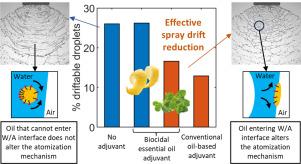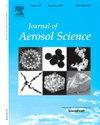Traditional agrichemical formulations are often composed of synthetic ingredients that may exhibit adverse environmental and health effects. Losses from spray drift mean that these potentially toxic ingredients can contaminate the environment and pose significant risks to human health. There is therefore a need for natural ingredients to formulate agrichemical sprays that are non-toxic to humans and less harmful to the environment to ensure greater safety and sustainability. Essential oils are promising candidates as natural biopesticides, but their application is limited due to their phytotoxicity at biocidal-effective dosages. A novel alternative approach utilizes essential oils as dilute oil-in-water emulsion spray adjuvants. This strategy can potentially reduce the usage of conventional pesticide ingredients by synergistically enhancing their effectiveness and reducing losses from spray drift. In this study, we evaluated the anti-drift potential of using plant-derived essential oils and quillaja saponin (a natural surfactant) to prepare dilute oil-in-water emulsions for use as safe and sustainable agrichemical adjuvants. In this study, we evaluated the potential of plant-derived essential oils and quillaja saponin, a natural surfactant, to create dilute oil-in-water emulsions as safe and sustainable agrichemical adjuvants. We found that emulsions made with methylated seed oil (MSO) and quillaja saponin showed similar drift reduction performance to those made with MSO and Tween 80, a synthetic non-ionic surfactant. Carvacrol (oregano and thyme essential oil) in water emulsion was found to increase the spray droplet size, thereby making it a promising ingredient for drift reduction. However, we found that limonene (citrus fruits essential oil) in water emulsion had no drift reduction abilities at the same specifications. The different performances of the two essential oils likely arise from differences in their physicochemical properties, which influence the spray atomization mechanism, specifically the ability of the oil droplets entering and spreading on the water–air interface to form perforations.



